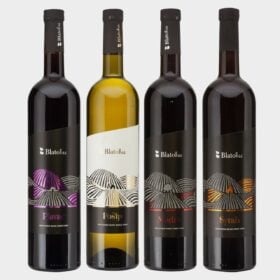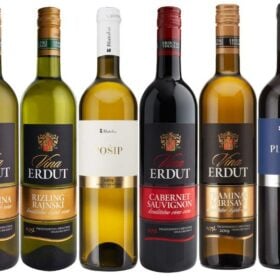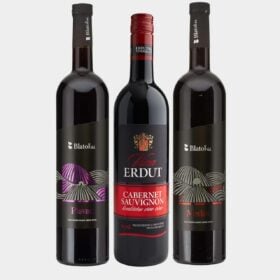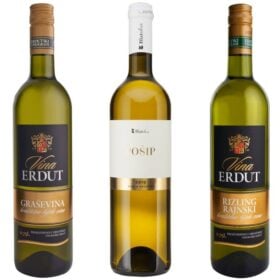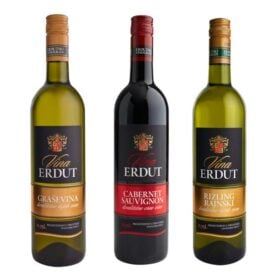Dive deep into the enchanting world of Reserva wine, where tradition and craftsmanship come together to create a symphony of flavors and aromato create images that stimulate the senses. In this article, we invite you on an enriching journey that will take you through the winding vineyards, where time itself seems to slow down, and each grape tells the story of a heritage imbued with passion and dedication.
From the historic roots that nourish this unique wine variety to the innovative approaches taken by today's producers, you will discover a world where every detail has been carefully orchestrated to create a product of unparalleled quality. As we guide you through the extensive process of grape variety selection, harvest techniques, and the art of aging and bottling, you will appreciate the depth of knowledge and expertise that goes into every bottle of Reserva wine.
Content
Reserva wine is not just a designation
In the wonderful world of wine, the term “reserva” is not just a designation; it is a promise of quality, a sign of its complexity and rich heritage spanning generations of winemaking tradition. The intriguing journey of a reserva wine begins in the vineyard, where each grape is grown with the utmost care and attention, and continues into the wine cellars where the maturation process takes place, a period during which the wine transforms and refines itself into a product of excellent quality .
But what makes a wine “reserve wine“? Where does this name come from, and how has it developed over time? In this article, we delve deep into the world of Reserva wines, exploring the historical context of this appellation, the legal provisions governing its classification, and the specific characteristics that distinguish Reserva wines in the rich and diverse world of wines.
As a lover of good wine, or simply as a curious reader, this article will take you on a journey through time and space, unraveling the subtle nuances and special qualities that a reserva wine brings. We will also take a look at the economic and social influences of reserva wines, and how they have found a place in the hearts and cellars of wine lovers around the world.
Prepare for an enriching experience in which you will discover the complexity and finesse of reserva wines, an experience that will certainly inspire you to explore the depths of this special category of wines for yourself.
History of Reserva Wine
Origin of Reserva wine
In the annals of wine history, we find that the term “reserva” has its roots in the ancient wine-growing traditions of countries such as Spain and Italy, where the concept of reserving some of the best barrels from a good harvest has been around for centuries. These barrels were specially reserved for special occasions or for the nobility and royalty. Over time, this practice became further formalized, and “reserva” came to be synonymous with wines of higher quality and superior aging.
Historical significance of “Reserva”
The word “reserva” carries with it a history of exclusivity and luxury. In ancient times, the reservation of these wines was a symbol of prestige and a sign of an exceptional harvest. These wines were often stored in the best conditions and were known for their complex flavors and... aroma's that developed over time. This created a culture in which reserva wines were considered special entities within the wine world, characterized by their aging time and excellent quality.
Evolution of Reserva wines
With the passage of time, the reserva wine tradition has undergone significant evolution. From a symbol of luxury and exclusivity, it is now a regulated term representing strict standards and quality criteria in various wine-producing regions. Contemporary wine growers approach reserva winemaking with a combination of traditional methods and modern techniques, resulting in wines that reflect both the wine industry's rich history and innovative approaches. This evolutionary process has paved the way for a wide range of reserve wines that offer a unique and rich taste experience, loved by wine lovers worldwide.

Legal provisions and classifications
Definition of “Reserva” in various wine producing regions
Although the term “reserva” has its origins in European countries such as Spain and Italy, its use has spread throughout the world. In several regions, it refers to wines that meet certain legal criteria in terms of aging time and production methods. It is crucial to understand the varying definitions of “reserva” as applied in different wine producing areas, as this designation can impact both consumer expectations and the market value of the wine.
Legislative aspects of Reserva wine
In many wine-producing countries, there are strict rules determining which wines can carry the prestigious “reserva” designation. These regulations may include criteria such as minimum ripening time in the cellar, specific production methods, and certain grape varieties to be used. The purpose of these legal provisions is to maintain the quality and integrity of reserva wines, and to protect consumers from misleading marketing practices.
Classifications and labels
The classification and labeling of reserve wines are of great importance for the identification and authentication of these products. In Italy for example, wines are classified as DOC (Denominazione di Origine Controllata) or DOCG (Denominazione di Origine Controllata e Garantita), depending on a set of strict criteria that guarantee the quality and origin of the wine. In Spain, wines are often categorized as “Reserva” or “Gran Reserva” based on their aging time and production methods, which gives an indication of their quality and complexity. These labels serve as a guarantee for consumers, providing information about the quality and characteristics of the wine they purchase.
Spain
In Spain, wine classifications are strictly regulated. The wines can be categorized as “Crianza”, “Reserva” or “Gran Reserva” depending on their aging time and the grape varieties used. “Reserva” wines are typically aged for a longer period than “Crianza” and shorter than “Gran Reserva”, ensuring a unique balance of freshness and complexity.
France
In France, the classification of wines is organized slightly differently, without a specific “Reserva” label. However, quality labels such as AOC (Appellation d'Origine Contrôlée) and IGP (Indication Géographique Protégée) help guarantee the origin and quality of the wines. These classifications are based on geographic location and strict production standards.
Italy
In Italy Wines with a “Riserva” label are often of higher quality, with strict aging requirements. These wines usually fall under the DOC (Denominazione di Origine Controllata) and DOCG (Denominazione di Origine Controllata e Garantita) classifications, which maintain strict standards regarding grape varieties and production methods, to preserve the integrity of Italy's winemaking tradition.
Croatia
Although Croatia is a lesser known player on the world wine stage, it has a rich wine tradition with its own classification system. Quality wines are referred to as “Kvalitetno Vino”, and those of exceptional quality as “Vrhunsko Vino” such as wine from the winery Blato 1902. These classifications guarantee that the wines have been produced to strict standards, including "terroir" and grape variety play a crucial role.
Portugal
Portugal, famous for its port wine and Vinho Verde, classifies its quality wines under the labels “Denominação de Origem Controlada” (DOC) or “Indicação Geográfica” (IG). These labels give an indication of the geographic origin of the wine, as well as its quality, with DOC wines having to meet stricter standards than IG wines, comparable to the French AOC system.
Germany
In Germany, quality wines are often referred to as “Qualitätswein” or “Prädikatswein”, which must meet certain quality standards and tests. These classifications are based on the ripeness of the grapes and the winemaking methods used. “Reserva” is not common here, but the emphasis is on the quality and sugar content of the grapes at harvest.
Austria
Austria has a strict system for classifying its wines, with quality labels such as “Qualitätswein” and “Prädikatswein”. Here the focus is on the origin and quality of the grapes, with different quality levels indicating the degree of sweetness and complexity of the wine. “Reserve” wines are often rich and complex, with a higher alcohol content than standard wines.
Greece
Greece has a centuries-old winemaking tradition, and uses a classification system similar to that of France. Quality wines are often labeled “OPE” (Oinos Proelefsis Eleghomeni), which indicates a controlled designation of origin. This label gives an indication of the geographic origin of the wine, as well as the grape varieties and production methods used, highlighting the unique qualities of Greek wines.
United Staten
In the United States, wine is classified according to the AVA (American Viticultural Area) system, which defines geographic areas with distinctive growing conditions. Although there is no official “Reserva” classification, some producers use this label to indicate higher quality or longer maturation, but this is not legally regulated.
Australië
Australian wines are divided into several classifications, including “Geographical Indications” which indicate the geographical origin of the wine. Although “Reserva” is not officially used, labels such as “Reserve” often indicate higher quality wines, with stricter production standards and longer aging times, yielding a more complex and refined product.
South Africa
In South Africa there is the WO (Wine of Origin) system which classifies wines based on their geographical origin. As in other non-European countries, the “Reserva” label is not officially recognized, but the use of terms such as “Reserve” or “Barrel Select” on the label may indicate a higher quality wine with a longer aging period.
Chile
Chile has a Denominación de Origen (DO) system based on geographical areas. The country also uses a wine classification system similar to that of Spain, including a “Reserva” classification. “Reserva” and “Gran Reserva” in Chile indicate wines with a longer aging period and often a higher alcohol content, indicating higher quality and complexity.
Argentina
In Argentina, wine is classified by the INV (Instituto Nacional de Vitivinicultura) according to geographical areas and certain quality standards. Although there is no official “Reserva” classification, this term is often used by winemakers to denote wines that require longer aging and higher quality, which often have more complex flavors and aroma's than have their standard counterparts.
Wine making process of wine
Selection of grape varieties
Every Reserva wine process begins with the careful selection of grape varieties. The choice of grape variety is crucial because it lays the foundation for the taste, aroma and complexity of the wine. Typically, reserva wines are higher quality grapes that are harvested manually to select only the best grapes, contributing to a superior wine experience.
The harvest
The harvest is a critical stage in the winemaking process. For reserve wines, this is often done at the optimal time when the grapes have reached peak ripeness, to achieve the perfect balance of sweetness and acidity to assure. This process is often done by hand to preserve the integrity of each grape, ensuring a high-quality base for the wine.
Pressing and fermenting
After harvesting, pressing follows, where the juice is extracted and fermentation begins. With reserva wines, this process is carefully managed to obtain the desired characteristics of the wine. The fermentation, in which sugars are converted into alcohol, is often controlled to maintain optimal temperatures and time periods, contributing to the complexity and depth of flavors in the final wine.
Maturation and barrel aging
Maturation is a distinguishing feature of reserva wines. These wines undergo a long maturing process, often in oak barrels, which gives them their complex aroma's and flavors can develop. This process not only makes the wine softer and more harmonious, but also allows the wine to acquire unique characteristics from the barrel in which it is aged, such as vanilla notes from American oak or spicy notes from French oak.
Bottling and further maturation
After barrel maturation, the wine is bottled, where it can mature for several months to years to develop further. This additional aging time in the bottle allows the wine to integrate and mellow its flavors, creating a smooth and well-rounded wine. It is this phase that often results in the deep and complex flavor profiles that characterize reserva wines.
Quality control and labelling
Before Reserva wines are released to the market, they undergo strict quality controls to ensure that they meet the high standards required of this label. This includes laboratory tests and tastings by experts. Once approved, the wines are labeled with appropriate classifications and labels that provide information about their origin, aging time and other relevant details so that consumers can make informed choices when purchasing these premium wines.

Preparation process of reserve wine
Selection of grape varieties
When making reserva wines, a lot of attention is paid to the selection of grape varieties. Depending on the region, specific grape varieties are used that are most suitable for the production of reserve wines. The types may vary, but quality is a constant factor. This section will discuss how the selection of grape varieties takes place, taking into account the climatic and geographical factors of the wine region.
Climatic Factors
Climate plays a crucial role in the selection of grape varieties. Variables such as temperature, precipitation and the amount of sunlight have a direct influence on the growth of the grapes. Producers often choose grape varieties that are well adapted to the local climate, ultimately resulting in a higher quality wine. A comprehensive study of microclimates can even point to the best specific locations for certain grape varieties.
Geographic Factors
The geographical factors, including soil type, altitude and slope of the vineyard, also determine the selection of grape varieties. The soil composition can... minerality and influence the taste of the wine, while the altitude and slope can contribute to optimal ripening of the grapes. Carefully selecting a location that is complementary to the chosen grape variety can result in a reserva wine with a richer and more complex profile.
Influence of the Grape Variety on the Wine
The choice of grape variety has a significant influence on the final character of the wine. Various grape varieties offer a range of flavors, aromaphotos and textures. With reserve wines, people often look for grape varieties that can produce complex, ripe and full-bodied wines. Knowing and understanding the unique characteristics of each grape variety helps winemakers create wines with depth and a distinct personality.
The harvest
The harvest is a crucial moment in the winemaking process. This is where the foundation is laid for the final taste and flavor aroma of the wine. This section covers the optimal timing of the harvest, the methods used, and how this process affects the final quality of the reserve wine.
Timing of the harvest
The timing of the harvest is a critical factor that can significantly influence the quality and profile of the wine. The correct harvest time is determined by various factors such as the ripeness of the grapes, the... sugar– and acid content, and weather conditions. Precise timing ensures that the grapes are picked at their peak quality, helping to create a superior reserve wine.
Methods of harvesting
Various methods of harvesting are used in the wine industry, including manual harvesting and mechanical harvesting. Manual harvesting allows winemakers to select the best grapes and ensures delicate handling of the grapes, while mechanical harvesting offers efficiency and speed. The choice of harvest method can affect the integrity of the grapes and the final quality of the wine.
Influence on the quality of the wine
The harvesting process has a direct influence on the quality of the wine. Careful selection and handling of the grapes during harvest can result in a wine with a more complex and balanced flavor profile. In addition, the timing of the harvest can affect the sugarinfluence the acidity ratio in the wine, which is crucial for achieving the desired taste and flavours aromaproperties in reserve wines.

Pressing and Fermentation
This stage is crucial in determining the character of the wine. The pressing and fermentation process is described in detail, highlighting the techniques used to extract the highest quality juice and the fermentation methods that contribute to the unique profile of reserva wines.
Techniques of Pressing
Pressing techniques are crucial to obtain the desired characteristics of reserva wines. Traditional methods may include gentle manual pressing to preserve the integrity of the grape, while modern pressing machines allow for efficient and consistent extraction. The choice of pressing technique can influence the amount of extraction tannins and other compounds important for the structure and flavor of the wine.
Fermentation process
The fermentation process, in which sugars are converted into alcohol and other substances, is a key stage in wine production. This can be done through spontaneous fermentation with wild yeasts or controlled fermentation with cultivated yeasts. The process must be carefully managed as it greatly affects the final taste, it aroma and the complexity of the reserve wine.
Development of taste and aroma
During pressing and fermentation the wine develops its primary flavors and aromas. These initial profiles are further developed and intensified during the ripening process. The winemaker has the opportunity to use different techniques and strategies to achieve the desired flavors aromaprofiles, including the choice of yeasts and the control of fermentation temperature, both of which have a significant impact on the final product.

Maturation and barrel aging
This section explains the process of maturation and barrel storage, a phase in which the wine develops its complexity and nuances. It specifically discusses the duration of maturation, the types of barrels used and how these elements contribute to the final taste and aroma of the wine.
Duration of Maturation
The duration of maturation is an essential aspect when making reserva wines. It ensures the development of complexity and depth in the wine. The period of maturation varies considerably and is often a reflection of the winemaker's vision and the unique characteristics of the grape variety. Long-term maturation can help create a wine with richer flavors and more layering aroma's.
Types of Barrels
The choice of barrels is a crucial element in the maturation process. Becoming traditional oak barrels used, that unique one aromaAdding 's and flavors to the wine. The type of oak, the size of the barrel and the duration of use can all influence the final product. Other options such as stainless steel tanks or concrete barrels are also used, each with their own influence on the wine's flavor profile.
Influence on taste and aroma
Maturation and barrel aging are fundamental steps that significantly influence the taste and texture aroma of the wine. The interaction between the wine and the barrel can allow for the development of complex wines aroma's and flavors, including notes of vanilla, spices and toast. Carefully managing this process is essential for creating a reserve wine with a harmonious and balanced profile.

Bottling and further maturation
After barrel storage, the wine is bottled, a process that also affects the final quality of the wine. This section discusses the bottling process, aging in the bottle and how these steps contribute to creating a superior reserve wine.
The bottling process
The bottling process is a crucial phase in the production of reserve wines. This involves filling the bottles with wine and sealing them with a cork or screw cap to maintain quality. During this process, the wine can be filtered to remove unwanted particles, resulting in a clear, pure wine ready for further maturation.
Maturation in the bottle
After bottling there is a period of maturation in the bottle. This stage ensures the development of secondary and tertiary aroma's, which contribute to the complexity and depth of the wine. During this period, flavors can merge and evolve, resulting in a harmonious and refined product that is characteristic of high-quality reserve wines.
Influence on the final quality
Bottle aging has a significant influence on the final quality of the wine. It promotes the integration of aroma's and flavors and can also provide a softer and rounder texture. A well-managed bottling and maturation process can take a reserva wine to the next level, resulting in a product with exceptional finesse and a layered, profound flavor profile.

Quality Control and Labeling
Before the wine is put on the market, it undergoes strict quality controls. This segment covers the methods and criteria of quality control, as well as the labeling that provides information about the origin and other important characteristics of the wine.
Methods of Quality Control
The methods of quality control in the production of reserve wines are rigorous. This can range from regular laboratory tests to check chemical composition, to sensory assessments by experienced oenologists who evaluate color, smell, and taste. This process ensures that every bottle of wine that leaves the vineyard meets the highest quality standards.
Criteria for Quality Assessment
The criteria for quality assessment can vary, but generally focus on aspects such as the clarity of the wine, its complexity aroma, the balance in the mouth and the aftertaste. Furthermore, the structure and body of the wine can also be integrated tannins, and the overall harmony between the different elements of the wine serve as indicators of quality.
Information on the Label
The information on the label of a bottle of Reserva wine provides insight into its quality and origin. It contains crucial details such as the name of the producer, the year of harvest, the region of origin and possibly a quality designation. Additionally, the label can provide clues about the grape varieties used, aging time and other factors that contribute to the wine's unique profile.
Characteristics of Reserva wine
Reserva wines have an exalted status in the wine world, celebrated for their distinctive qualities that come with patient craft and time. Often reserved for special occasions, these wines represent the highest form of art and science found in winemaking. In this segment we explore the unique characteristics of reserva wines, distinguishing them in flavor profiles and aroma's, the influence of "terroir", and the culinary combinations they compliment. Dive with us into the world of reserve wines and discover what makes these nectars of the gods so special.
Flavor profiles and aroma's
The flavor profiles and aromaReserva wines are a true testament to their excellent aging process. These wines are often rich in complexity, with the flavors and aromas developing over several years, resulting in a layered, deep experience with every sip.
Characteristic of reserva wines are often intense, but balanced taste notes of dark fruit such as black cherries and plums, enriched with notes of spices and sometimes a hint of vanilla, coming from the oak barrels in which they ripen. AROMA's can range from floral to spicy, with nuances of cedarwood and tobacco developing over time.
In addition, the secondary and tertiary carry aroma's, which arise during the long maturing process, contribute to the layering and complexity of the wine, where hints of leather, truffle or even forest floor can be noticed, which give a rich, almost tangible texture to the wine.
Influence of "terroir" on Reserva wines
The concept of '"terroir"' is a fundamental element in the world of winemaking. It refers to the unique combination of natural factors — including soil, climate and topography — that directly influence a wine's characteristics. In the case of reserva wines, that plays a role "terroir" an even more crucial role in determining their unique profile.
These wines often reflect the nuances of the region in which they are produced, with every element of the "terroir" contributes to the final complexity and depth of the wine. Whether it is the mineral wealth of the soil, the temperature control of a cool mountain climate, or the specific sun exposure, every aspect of the "terroir" is absorbed and transformed into subtle flavor nuances in the wine.
As you immerse yourself in the world of reserva wines, you will recognize the influence of "terroir" helping you gain a deeper understanding and appreciation of the subtleties and complexities these wines have to offer.
Economic and social influences
Reserva wines as an economic driving force
Reserva wines have a prominent role in the economies of many wine-producing regions. The long maturation and craftsmanship required for production create significant economic value. Wineries that specialize in reserva wines often generate more revenue compared to those that focus on standard wines, thanks to the higher price range and exclusivity of reserva products.
Furthermore, they also encourage tourism, with wine lovers traveling from far and wide to sample these prestigious wines taste and experience them in their natural habitat. It also creates employment and promotes local businesses that provide services and products necessary for wine production.
Social and cultural influences of Reserva wines
The rich tradition of reserva wines is deeply woven into the social and cultural fabric of the societies where they are produced. These wines are often associated with celebrations, ceremonies and important events, reinforcing their status as premium products. Reserva wines are also the center of many cultural traditions, such as wine tastings and festivals that bring together and unite people in a celebration of the craftsmanship that goes into every bottle.
The social and cultural impact of these wines goes beyond just economic value. They represent the history, heritage and pride of a region, and enjoying a glass of reserva wine is often an experience that awakens the senses and provides a deep appreciation for the art of winemaking.
Trends in the consumption of Reserva wines
In recent years we have observed some notable trends in the consumption of reserva wines. A growing preference for quality over quantity is one of the most prominent trends, with consumers increasingly willing to pay a premium for wines with a rich history and superior production methods.
In addition, there has also been an increase in online sales of these wines, partly due to greater awareness and appreciation for the nuances of reserva wines through online platforms and social media. Likewise, there is a rise in wine clubs and subscription services that offer exclusive access to premium reserva wine selections.
Additionally, there is a growing interest in sustainable and organic viticultural practices, with consumers increasingly placing value on the environmentally friendly aspects of wine production.
These trends indicate a flourishing future for reserva wines, with a continued focus on quality, tradition, and sustainability.
Conclusion
After an extensive exploration of the world of reserva wines, it remains clear that this unique segment of the wine industry represents a rich tapestry of history, tradition, and culinary art. From the strict legal provisions established to ensure the quality and authenticity of these wines, to the meticulous care given to every aspect of the winemaking process, Reserva wines are synonymous with excellence and refinement.
The journey we undertook included an in-depth look at the historical background of these wines, examining the influence of various geographical and climatic factors that contribute to their unique flavor profiles and aroma's was emphasized. Entering the vineyard during harvest, it teaching methodology from the art of pressing and fermentation, to understanding the complexities of maturation and barrel choice, has opened a window into the passionate world of winemaking.
Likewise, we highlighted the economic and social dynamics impacting this sector, pointing to the upward trends in the consumption of reserva wines and the growing appreciation for their quality and tradition. In addition, we delved into the stories of prominent wine producers, their philosophies and the successes and challenges they face in an ever-changing market.
After this enrichment of your knowledge of Reserva wine, we invite you to experience the sublime quality and unique nuances of Croatian wines for yourself – your glass of exceptional quality awaits you in our collection.


